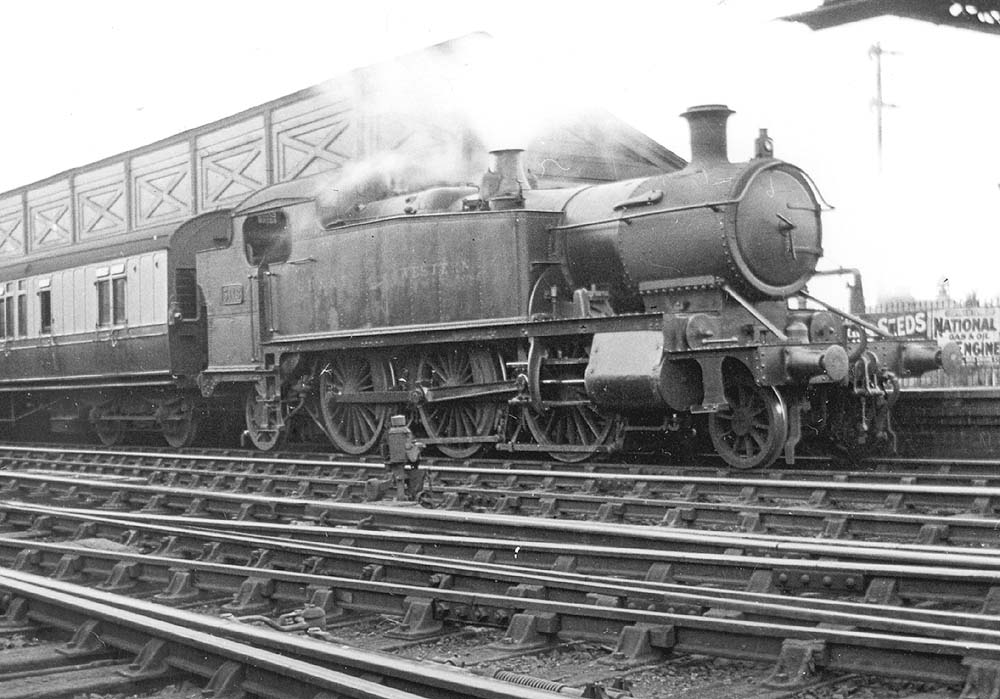 |
|
GWR Route: Banbury to Wolverhampton
Leamington Spa - Grouping Locomotives: gwrls887
 |
GWR 2-6-2T 31xx class No 5118 rests at the head of a
Birmingham service with a rake of 70' 'Toplight' coaching stock behind its
bunker. The locomotive was built in February 1905 at Swindon as No 3118 as part
of lot 150 and was initially allocated to Newport shed (NPT). The prototype
locomotive No 99 (later No 3100) had been designed and built in 1903 by the
Great Western Railway’s Chief Mechanical Engineer – George Churchward
and this locomotive was trialled for a year before a further thirty nine
similar locomotives were constructed with minor improvements. These included
larger (2,000 gallon capacity) sloping side tanks with two way steam operated
water pick-up apparatus. The poor weight distribution resulted in a maximum
axle weight of 18 tons, 4cwt, but this was reduced by limiting the tank
capacity to 1,600 gallons (a policy introduced in 1927). The whole class had
also their coal bunkers extended circa 1920 to hold 18cwt. The boiler pressure
was originally 195 lbs and No 3118 had a superheated boiler fitted in May 1911.
In 1919 the boiler pressures were increased to 200 lbs, which produced a
tractive effort at 85% was 24,300 lbs (power group D). See
Engine Route Map and
Capabilities for more details.
In 1928, a redistribution of the locomotive's weight allowed
the full 2,000 gallon tank capacity to be utilised while also reducing the
maximum axle weight to 17 tons, 12 cwt (route colour – Blue). All the
class were similarly treated and when finished the locomotives were renumbered
in to the 51xx class (with No 3118 became No 5118 in May 1928). After the
rebuild No 5118 was initially allocated to Leamington shed (LMTN), but had
moved to Bristol shed (SPM) by 1934 and was withdrawn from there in March 1938.
This however was not the end for the locomotive’s frames were used with
new front ends for locomotive No 8102 which was built at Swindon under lot 320
and taken in to service in June 1938. The 2-6-2T 81xx class had new higher
pressure boilers (225lbs) and smaller driving wheels (five foot, six inches
instead of five foot, eight inches) and this increased the acceleration which
was necessary on frequently stopping suburban services. It was intended to
modify fifty 51xx locomotives under lot 320, but the war intervened and No 8102
became the third member of a new class of only ten locomotives. No 8102 was
initially allocated to Tyseley shed (TYS) and remained in service until May
1964, when it was withdrawn from Worcester shed (85A) before finally being
scrapped in September 1964 at Swindon works.
The first coach is a 57 foot long non-corridor
‘toplight’ brake third (diagram D49) built in 1911 as part of lot
1188 specifically for the burgeoning suburban passenger services in Birmingham.
These brake thirds coaches were included at each end of four dedicated rakes,
each of four coaches, which in the Birmingham Division were termed 'B sets'.
Each set comprised; brake third (D49) – composite (E89) – composite
(E89) – brake third (D49). The coaches had electric lighting powered by
the Leitner system with a dynamo and twelve cell battery beneath each of the
brake third coaches. All of these four coach sets were transferred to the
London Division suburban services in 1931 and they were condemned in April
1955. Details of the coaches in these four B sets are given below:
An article appeared in the Great Western Railway magazine
(June 1911) shortly after the introduction of these coaches, seeimage 'gwrms1730' for more details.
 back back

|
